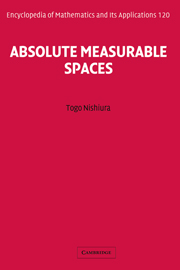Book contents
- Frontmatter
- Contents
- Preface
- Acknowledgements
- 1 The absolute property
- 2 The universally measurable property
- 3 The homeomorphism group of X
- 4 Real-valued functions
- 5 Hausdorff measure and dimension
- 6 Martin axiom
- Appendix A Preliminary material
- Appendix B Probability theoretic approach
- Appendix C Cantor spaces
- Appendix D Dimensions and measures
- Bibliography
- Notation index
- Author index
- Subject index
Appendix D - Dimensions and measures
Published online by Cambridge University Press: 14 May 2010
- Frontmatter
- Contents
- Preface
- Acknowledgements
- 1 The absolute property
- 2 The universally measurable property
- 3 The homeomorphism group of X
- 4 Real-valued functions
- 5 Hausdorff measure and dimension
- 6 Martin axiom
- Appendix A Preliminary material
- Appendix B Probability theoretic approach
- Appendix C Cantor spaces
- Appendix D Dimensions and measures
- Bibliography
- Notation index
- Author index
- Subject index
Summary
This appendix contains a summary of the needed topological dimension theory, and, for metric spaces, the needed Hausdorff measure theory and the Hausdorff dimension theory.
Topological dimension
There are three distinct dimension functions in general topology, two of which are inductively defined and the third is defined by means of open coverings. Each definition has its advantages and its disadvantages. Fortunately, the three agree whenever the spaces are separable and metrizable. Let us give their definitions.
Definition D.1. Let X be a topological space.
The space X is said to have small inductive dimension −1if and only if it is the empty space. For each positive integer n, the space X is said to have small inductive dimension not exceeding n if each point of X has arbitrarily small neighborhoods whose boundaries have small inductive dimension not exceeding n − 1. These conditions are denoted by ind X ≤ n. The definition of ind X = n is made in the obvious manner for n = −1, 0, 1,…, +∞
The space X is said to have large inductive dimension −1if and only if it is the empty space. For each positive integer n, the space X is said to have large inductive dimension not exceeding n if each closed subset of X has arbitrarily small neighborhoods whose boundaries have large inductive dimension not exceeding n−1. These conditions are denoted by Ind X ≤ n.
- Type
- Chapter
- Information
- Absolute Measurable Spaces , pp. 244 - 257Publisher: Cambridge University PressPrint publication year: 2008

